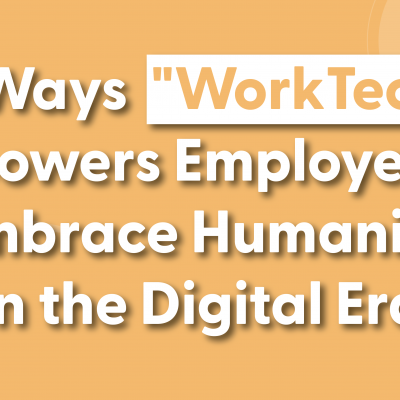“The promise of tech is often that it will eliminate, or make easier, the things that we simply don’t want to do. The things that make us feel less human.” – Aaron Delgaty, PhD., Practice Leader of Experience Research @ The Starr Conspiracy
As the proliferation of technology marches onward and our lives become more intertwined with SaaS, Apps, and Portals, employers are feeling the heat to find ways for employees to feel their humanity isn’t lost in the digitization evolution.
WorkTech integrates collaboration, productivity, and People Ops processes with the aim of enhancing the employee experience through the application of technology in the workplace. While no two tech solutions are created equal, in the world of People Ops they typically have these two similar characteristics when viewed from 10,000’:
- They impact the burden (hopefully in a positive way) of the People Ops pro managing the technology for the organization.
- They impact the lives of the employees who are being asked to use the technology.
While that may seem reductive, People Operations leaders find themselves in a unique situation when it comes to WorkTech in that perhaps unlike other areas of a given business, any WorkTech solution introduced into a People Ops process has to be extremely mindful of characteristic number 2.
With the right WorkTech solution, digitization doesn’t have to come at the expense of humanity, and in some cases, creates a sense of humanity where it was previously seriously lacking.
Below we break down five ways WorkTech can help employers embrace humanity in the digital era to demonstrate how the right tech can make all the difference to People Ops and the employees they serve.
And it’s not for a lack of effort on your part. You’ve likely either inherited inefficient and ineffective legacy systems to manage your LOAs, or you simply don’t have the bandwidth to keep up to date on leave laws, administer your policies consistently, guide employees through all the programs they have to apply for, and answer the multitude of urgent leave-related questions that your employees may have at a moment’s notice.
LOAs…they’re a lot, and unfortunately if you’re relying on having to manually update spreadsheets while coordinating between disparate and outdated systems (looking at you state departments and some…not all…STD carriers) only to provide a cold and cloudy user experience to employees is a rocky foundation to build your employee experience empire upon.
Tilt Recap: Leaves are complex, and traditional approaches to managing them put People Ops leaders at a disadvantage for their successful administration, thus putting your employee experience at risk when they need it most.
1. WorkTech Automation for Mundane Tasks
Let’s take one particularly human process that every organization and People Ops team has to navigate, the leave of absence process. Where a manual leave of absence process is an administrative dumpster fire for you to manage, it can be a cold, confusing, and sometimes intimidating process for your people.
Automation through modern LOA management software allows you and your team to focus on more meaningful and creative aspects of your work by automating repetitive and mundane tasks, removing human error, and keeping you compliant. This not only increases your efficiency at a critical job function but also frees up your team’s time to do more meaningful and impactful work.
Similarly, your employees’ lives are made easier by streamlining an otherwise arduous process while being supported during a very complex, human time in their lives. A major element of leave of absence support is being able to answer questions that employees may have about during their leave, so in this case, the right WorkTech solution should also have an element of easy-to-access human support as well.
2. Data-Driven Decision-Making Made Easier With WorkTech
In the contemporary workplace, WorkTech catalyzes data-driven decision-making, revolutionizing how employers manage and optimize their workforce. By harnessing the power of data analytics, organizations gain insights into various facets of employee performance, engagement, and satisfaction. This analytical prowess allows employers to make informed decisions, tailor strategies, and address challenges with precision.
Using the same example as above, workforce analytics from modern leave management software can help uncover patterns related to turnover and trends in leave requests over time, enabling your organization to identify areas of improvement or allocate resources more efficiently. More on that in a minute.
The introduction of artificial intelligence and machine learning in WorkTech is beginning to bear fruit as well, equipping employers with real-time analysis, and empowering them with a dynamic and responsive framework. This data-centric approach not only enhances operational efficiency but also supports a human-centric culture of continuous improvement.
3. The Importance of HR Tools with Transparency
Transparency in your WorkTech tools is essential for fostering a positive workplace culture and nurturing employee trust. When your processes and data are transparent, employees feel more informed and empowered, which leads to increased job satisfaction as employees are given the clarity needed to feel fully supported.
Further, leveraging the leave of absence example one more time, transparency with your leave data (which should be accurate thanks to automation) gives your organization a window into workforce planning that they simply couldn’t have if you’re using a spreadsheet. Spreadsheets are great, but WorkTech they are not.
With the right LOA WorkTech solution, not only do employees stay informed about what they need to do on a leave, People Ops can easily see all leaves happening at any given time across the org, and managers can more effectively fill in the gaps. That means less employee burnout (good for humanity), business continues to thrive (good for humanity), cross-training opportunities may emerge (good for humanity), and the employee returns to work feeling supported and re-engaged (good for humanity).
Transparency can be a scary thing to some organizations, but the right tech solutions can make it easy. 87% of employees want their organizations to be transparent, and WorkTech can help.
4. HR Collaboration Made Possible Through Tech
People Ops Tech (or HR Tech) is really a subset of WorkTech overall. Where People Ops tech focuses on managing your human resources…well…humanly, WorkTech additionally aims to improve productivity and collaboration within the workplace. This is both a boost for employee well-being and your organization’s bottom line.
WorkTech’s collaborative tools stand as the cornerstone of a dynamic and interconnected workplace, redefining how teams collaborate across distances and time zones. In an era marked by globalized workforces and the rise of remote work, these tools play a pivotal role in breaking down physical barriers and fostering a culture of seamless collaboration.
Platforms like virtual team spaces, project management tools, and instant messaging applications facilitate real-time communication and cooperation among team members. The ability to share documents, conduct virtual meetings, and engage in collaborative editing enhances teamwork, ensuring that every member feels actively involved and contributes to collective goals.
With the advancement of virtual and augmented reality, expect WorkTech solutions to offer immersive workplace experiences that transcend physical boundaries in the near future.
5. How WorkTech Plays a Role in Organizational Inclusion
A truly diverse and inclusive work environment demonstrates empathy towards situations it may not fully understand. And it’s more than about being a good human to your humans, it’s good for business and good for retention as well, as Gartner research finds that in a diverse workforce, performance improves by 12%, and intent to stay by 20%.
WorkTech empowers employers to champion diversity and inclusion through targeted initiatives, creating workplaces that celebrate and embrace differences. Utilizing technology, organizations can implement inclusive hiring practices, ensuring unbiased recruitment processes and fostering diverse talent pools. Data-driven tools assist in tracking diversity metrics, enabling organizations to measure and improve their inclusivity efforts.
Moreover, WorkTech supports the development of inclusive digital environments, where employees feel valued and respected. From fostering open communication through inclusive collaboration platforms to utilizing AI for detecting and mitigating unconscious biases, technology plays a crucial role in shaping a workplace culture that appreciates diversity.
By leveraging WorkTech for diversity and inclusion initiatives, employers not only enhance organizational resilience but also tap into a wealth of varied perspectives, driving innovation and creativity. Ultimately, these initiatives go beyond compliance, fostering a workplace where individuals from diverse backgrounds thrive, contributing to a richer and more vibrant professional community.
WorkTech For a More Human Work Experience
The right WorkTech has the power to revolutionize your workplace, empowering your organization to cultivate a humane and employee-centric environment top to bottom. WorkTech champions automation, data, transparency, collaboration, and inclusion with its emphasis on continuous learning, enabling growth for individuals and the organization as a whole.
Data-driven decision-making ensures strategic and informed choices, while automation streamlines processes and removes frustration and confusion. Transparency delivers insights and fosters a sense of trust, and the commitment to diversity and inclusion promotes a harmonious workplace.
Together, these elements forge a work environment prioritizing holistic development and employee satisfaction. WorkTech is not just a tool; it’s a catalyst for a progressive, nurturing and human work culture.
About Tilt
Tilt is leading the charge in all things leave of absence management through easy-to-use tech and human touch. Since 2017, our proprietary platform and Empathy Warriors have been helping customers make leave not suck by eliminating administrative burdens, keeping companies compliant, and providing a truly positive and supportive leave of absence experience for their people.







